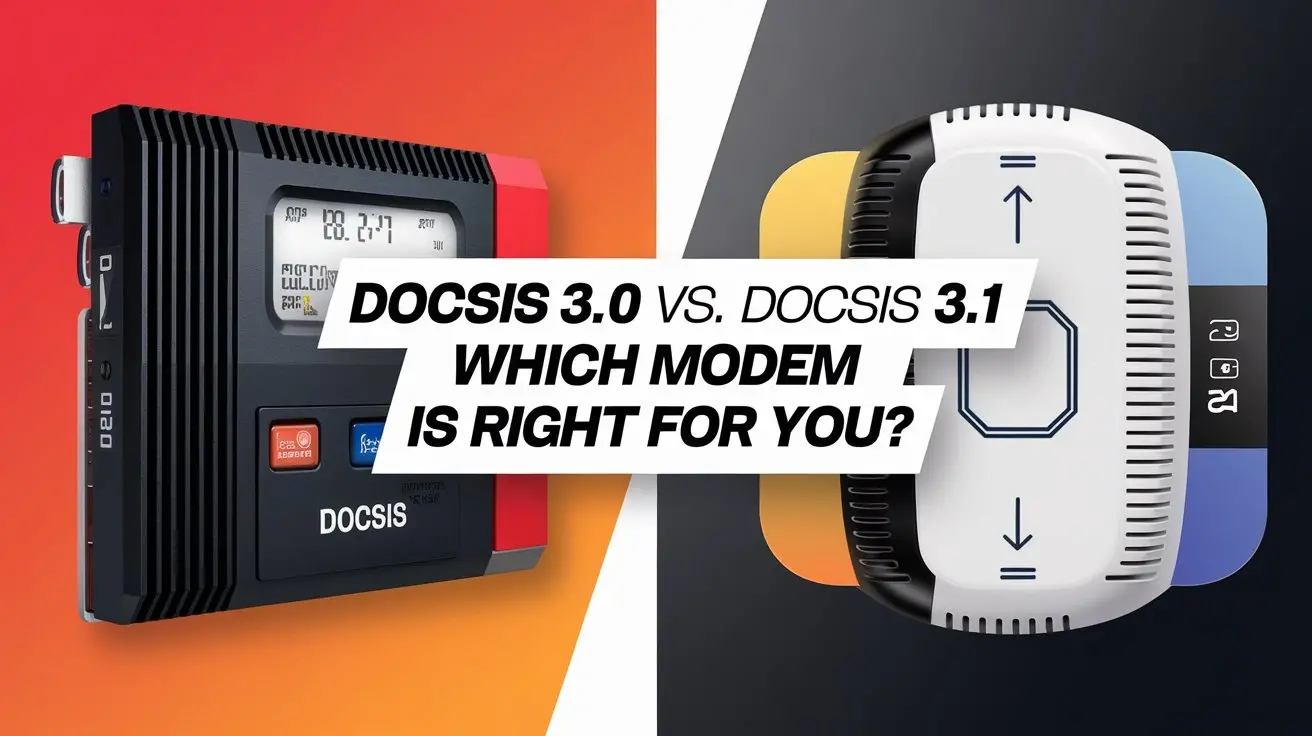
Of course, more is always better when it comes to modem choices, but to find the perfect modem for your home or business, there are many things to take into consideration. It detailed one of the key aspects of the modem: by the current standards, this technology is either DOCSIS 3.0 or DOCSIS 3.1. Every one of these technologies has its strengths and weaknesses and by identifying these distinctions you will decide on the most fitting technology for your needs. In this post, we are going to focus on the most important aspects of both DOCSIS 3.0 and DOCSIS 3.1 modems so that you can make the right decision.
1. DOCSIS 3.0 Overview
DOCSIS means Data Over Cable Service Interface specification and this is simply a protocol that is used by cable internet service providers to convey data from or to the consumer’s premises and to the cable provider’s network. DOCSIS 3.0 is the second version of the Data Over Cable Service Interface Specification (DOCSIS) that has a better performance than DOCSIS 2.0.
a) Speeds and Capacity
Officially, DOCSIS 3.0 modems can achieve download rates as high as 1 Gbps per second, but most cable providers at the time of this writing offer service at speeds between 100-300 Mbps. Your actual speeds may differ with your provider and plan, wiring, and the distance you live from your provider’s network equipment.
DOCSIS 3.0 provides up to 16 downstream channels and 4 upstream channels provoking higher data throughput than the prior specifications of DOCSIS. This has the effect of allowing more subscribers to be supported on the same cable plant; this may help lead to better overall network performance.
b) Channel Bonding
Another advantage of the DOCSIS 3.0 is channel bonding through which the modem can employ several channels to provide data transmission. Originally, a DOCSIS 3.0 modem could have eight downstream and four upstream bonded channels at most. This could offer a nice per cent marginal benefit to end users, especially if compared to DOCSIS 2.0 with the channel bonding that supported only a single downstream and upstream channel.
2. DOCSIS 3.1 Overview
DOCSIS 3.1 is the current DOCSIS technology that provides incredible advancement over the former versions in terms of growth rates, speed, and stability. This next-generation technology is therefore intended for the growing bandwidth demand,d especially in the streaming of high-definition video and gaming.
a) Speeds and Capacity
The max possible download speed of DOCSIS 3.1 is 10 Gbps and max of upload speed is 1Gbps. Of course, the speeds which you will get depends on your cable provider and the quality of your cables and wiring but at least DOCSIS 3.1 is significantly faster than DOCSIS 3.0. Also, DOCSIS 3.1 enables up to 1008 downstream channels and 192 upstream channels which provide much more capacity and the possibility to increase the speeds higher.
b) Improved Efficiency
One of the most important and distinguishing aspects of DOCSIS 3.1 is the enhancement of upstream and downstream data carrying capacity that can fit in a specific band of spectrum when compared with upgraded prior forms of the DOCSIS standard. This is achieved through a combination of an efficient coded encoding method and a novel modulation mode known as OFDM (orthogonal frequency division multiplexing), which subdivides the available frequency bandwidth into several independent streams.
c) Full-Duplex DOCSIS (FDX)
DOCSIS 3.1 also comes with FDX, as an enhancement that allows a cable modem to transmit and or receive data at the same frequency. This means high-speed data transfer for voice, data and other multimedia applications without needing other accessories and Spectrum.
3. Which Modem is Right for You?
Choosing between the two modem technologies, that is DOCSIS 3.0 and DOCSIS 3.1, there are several issues to consider.
a) Speed Requirements
If your online activities consist of simple web surfing, emails, and watching standard definition videos, then, a DOCSIS 3.0 modem is enough for you. However, If you often use high-definition videos, video gaming, or video conferencing, you may want to consider the DOCSIS 3.1 modem since it can handle such bandwidth-intensive operations.
b) Future-Proofing
DOCSIS 3.0 modems are currently much more widespread than DOCSIS 3.1, which promises to become the future of cable Internet. Purchasing a DOCSIS 3.1 modem at the moment can allow you to plan for future upgrades from your cable company while also guaranteeing yourself the best Internet speeds when such upgrades happen in the future.
c) Compatibility and Upgrades
Particularly when selecting a modem, it would be crucial to find out if it supports the provider’s cable infrastructure. A great number of cable providers have indeed installed DOCSIS 3.1 compatibility but there can be some areas or certain cable providers that are still using DOCSIS 3.0. Secondly, you should clarify whether your provider has plans where you could benefit from the DOCSIS 3.1 modem that provides higher speed and capacity.
d) Cost
Last, you should also need to take the price of a DOCSIS 3.1 modem into account with the intention of before purchasing. These devices are, in most cases, slightly pricier than their DOCSIS 3.0 counterparts, but, given improved performance and multiple configured future enhancements, the price difference might be worth it for some clients.
Conclusion
Nevertheless, there are certain benefits and drawbacks associated with both DOCSIS 3.0 and DOCSIS 3.1 modems based on which prospects should figure out what solution is better for them and their specific requirements. However, if you need a faster operation and you plan for the future, a DOCSIS 3.1 modem may attract you. Still, if you are satisfied with the current speeds and eager to cut the expenses, a modem of DOCSIS 3.0 standard should fit. Thus, the most effective approach to make the decision is to evaluate your actual downloaded/uploaded traffic, study your cable provider’s physical cables and service plans, and compare the advantages and disadvantages of the specified technologies.






